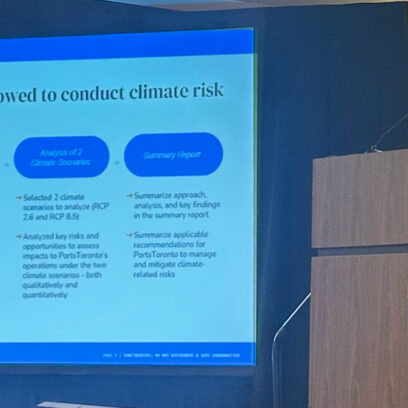Using Materiality Assessments to Unlock Environmental Priorities


FW Sustainability Report
Learn more about how Fierce Whiskers has made sustainable choices every step of the way by downloading its full sustainability report.
Learn how to pinpoint business activities with the most environmental impact and collaborate with suppliers for a sustainable future.
In a previous blog post, we highlighted the role of materiality in sustainability. Materiality helps businesses identify and evaluate the environmental, social, and governance (ESG) issues that matter most to them and their stakeholders. These “material issues” can pose risks but also present opportunities that can impact a company’s financial health, operations, and the wider environment and community. It’s worth noting that these issues can change based on environmental factors, societal shifts, and regulatory updates. In this post, the focus will remain on identifying top environmental impacts through materiality assessments. By conducting a materiality assessment, companies can prioritize their sustainability efforts, manage risks, and ensure their strategies align with stakeholder expectations, all with a focus on long-term benefits. In this post, we’re going to look at how materiality can help you make decisions in the real world.
Materiality-Informed Decisions: Balancing Business & Environment
Materiality helps companies decide which environmental initiatives to pursue. For example:
- A beverage company operating in a water-scarce region might prioritize water conservation, investing in rainwater harvesting or wastewater recycling.
- A tech company with large data centers, responsible for nearly 1% of global electricity consumption, might focus on energy efficiency, retrofitting facilities to reduce power consumption.
- A logistics company, with transportation accounting for 29% of global CO2 emissions, might transition to electric or hybrid fleets, reducing their carbon footprint and aligning with global emissions reduction targets.
Key stakeholder groups, from local communities to global investors, often have specific environmental concerns. By identifying and addressing these concerns, companies can mitigate business risks and foster stronger relationships.
Trade-Offs: Complex Materiality Decisions
Every sustainability initiative presents trade-offs. Materiality, rooted in data-driven assessments, can guide businesses through these complexities:
- Sourcing Dilemmas: A bakery chain might be faced with sourcing organic grains locally, supporting local farmers, versus importing non-organic grains from regions with advanced, less water-intensive farming techniques. Given that agriculture accounts for about 70% of global freshwater withdrawals, the decision can significantly impact a company’s water footprint.
- Packaging Challenges: A shift to lightweight packaging might seem beneficial due to reduced transportation emissions. However, if this packaging is non-recyclable, it could contribute to the over 380 million tons of plastic waste produced annually. Materiality assessments can help weigh the carbon savings against potential waste implications.
- Renewable Energy Transition: A manufacturing firm might consider transitioning to renewable energy sources. While solar and wind energy can significantly reduce greenhouse gas (GHG) emissions, the initial investment and infrastructure changes can be substantial. However, with renewable energy expected to supply 80% of global electricity by 2050, the long-term benefits might outweigh the initial costs.
Materiality-Based Decisions Across Industries
The following table provides a practical look at materiality in action, showing how different industries might prioritize environmental concerns and the steps they could take in response. This table is meant to be a starting point, to show how you can apply the concept of materiality when identifying your organization’s sustainability priorities, regardless of industry.
| Sector/Industry | Material Concern | Actionable Decision | Potential Impact |
| Beverage | Water scarcity | Invest in rainwater harvesting or wastewater recycling | Prioritize water conservation in water-scarce regions |
| Technology/Data Centers | High electricity consumption | Retrofit facilities for energy efficiency | Reduce power consumption and environmental footprint |
| Logistics | High CO2 emissions | Transition to electric or hybrid fleets | Align with global emissions reduction targets |
| Bakery | Water-intensive farming | Choose between local organic grains or imported non-organic grains with advanced farming techniques | Impact on company’s water footprint |
| Packaging | Transportation emissions vs. plastic waste | Balance lightweight packaging with recyclability | Weigh carbon savings against waste implications |
| Manufacturing | Renewable energy transition | Consider investment in solar and wind energy | Align with future global electricity supply trends |
| Textile | Insecticide use in cotton farming | Engage suppliers for sustainably farmed cotton | Reduce environmental impact and strengthen supplier relationships |
| Electronics | E-waste accumulation | Implement electronics recycling programs | Reduce environmental impact from electronic waste |
| Food/Restaurant | GHG emissions from livestock farming | Collaborate for humane animal treatment and sustainable grazing methods | Address global GHG emissions concerns |
Engaging Suppliers with Materiality
The supply chain is often a hotspot for sustainability challenges. Materiality can be instrumental in identifying and addressing these:
- Textile Industry Example: An apparel brand might engage with suppliers to ensure the cotton used is sustainably farmed, given that cotton farming is responsible for 24% of global insecticide use. Collaborative initiatives can lead to reduced environmental impact and foster stronger supplier relationships.
- Electronics Industry Example: For tech companies, managing e-waste is a significant environmental concern. Electronic products often contain hazardous materials that can harm the environment if not disposed of properly. Engaging suppliers to adopt and promote recycling and proper disposal methods can reduce environmental impact and align with global e-waste management standards.
- Food Industry Example: A restaurant chain might collaborate with suppliers to ensure meat products are sourced from farms practicing humane animal treatment and sustainable grazing methods, especially since livestock farming contributes to 14.5% of GHG emissions.
Conclusion
Materiality isn't a static concept—it evolves with changing business landscapes, stakeholder expectations, and global challenges. As businesses strive for deeper sustainability integration, materiality will serve as a compass, ensuring that efforts are not only impactful but also aligned with broader stakeholder concerns.
Interested in learning more about materiality and how it can shape your company's sustainability journey? Contact us today for guidance on materiality, carbon footprint measurement, goal setting, and more.
Materiality assessments should be conducted periodically, typically every 2-3 years. However, it's advisable to review them more frequently if there are significant changes in the business environment, regulatory landscape, or stakeholder concerns.
Yes, there are several recognized frameworks and guidelines, such as those provided by the Global Reporting Initiative (GRI) and the Sustainability Accounting Standards Board (SASB). These frameworks offer structured approaches to identify and prioritize material issues, though businesses often tailor them to their unique context.
Stakeholder engagement can be achieved through surveys, interviews, focus groups, or workshops. It's essential to involve a diverse group, including employees, customers, suppliers, investors, and community representatives, to gain a comprehensive understanding of material concerns.
After identifying the top environmental impacts, businesses should develop action plans or strategies to address these concerns. This might involve setting specific targets, allocating resources, and monitoring progress over time. Regular communication with stakeholders about the progress and challenges is also crucial.
Materiality assessments complement other sustainability reporting standards by helping businesses focus on the most relevant issues. Many reporting frameworks, like GRI or CDP, incorporate materiality as a core principle, ensuring that reported data is both relevant and meaningful to stakeholders.

Have a question? Della can help.
Della Jung is Director on CarbonBetter’s sustainability, decarbonization, and climate division. She brings extensive experience in private equity and infrastructure investing, fund operations, climate and sustainability strategy to help deliver effective solutions inclusive of both financial results and social impact for her clients. Based in Washington, D.C., Della holds a BA in Government from Dartmouth College.


